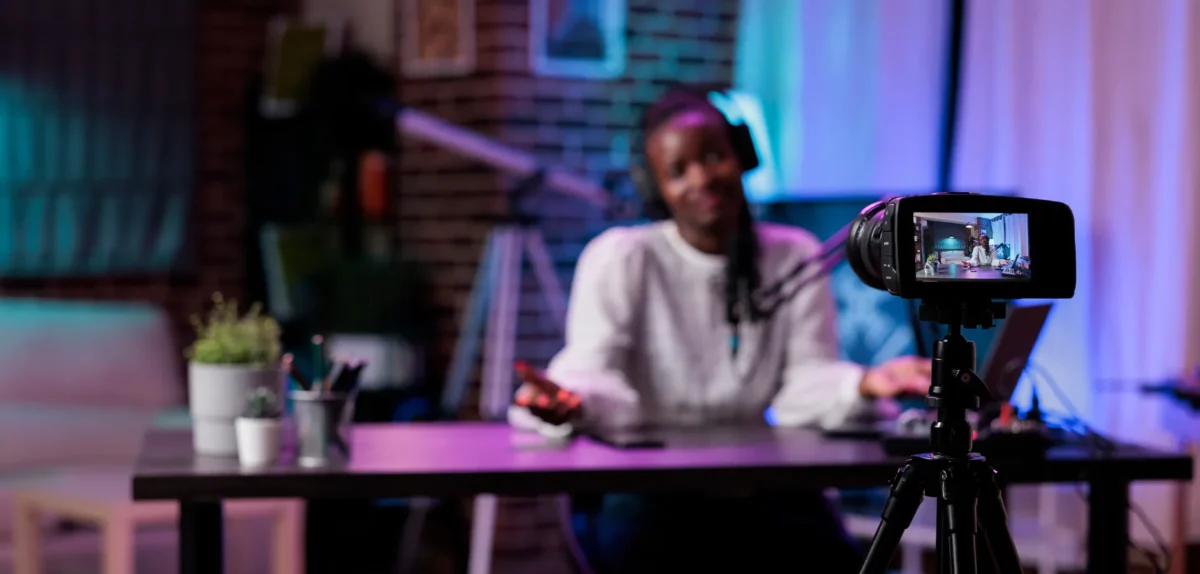When Patricia Bright reviews a financial tool on her YouTube channel or discusses a business resource on The Break, her audience doesn’t passively watch—they act.
The seasoned creator has built something most traditional influencers struggle with: genuine trust that converts viewers into customers.
She’s part of the creator economy revolution that’s reshaping marketing. Projected to reach $480 billion by 2027, the creator economy is driving brands away from polished advertisements and viral trends toward authentic voices that deliver real value.
This shift is forcing brands to rethink everything.
Instead of chasing celebrity-style influence and short-term buzz, smart marketers are investing in creator partnerships that prioritize trust, engagement, and long-term results over fleeting visibility.
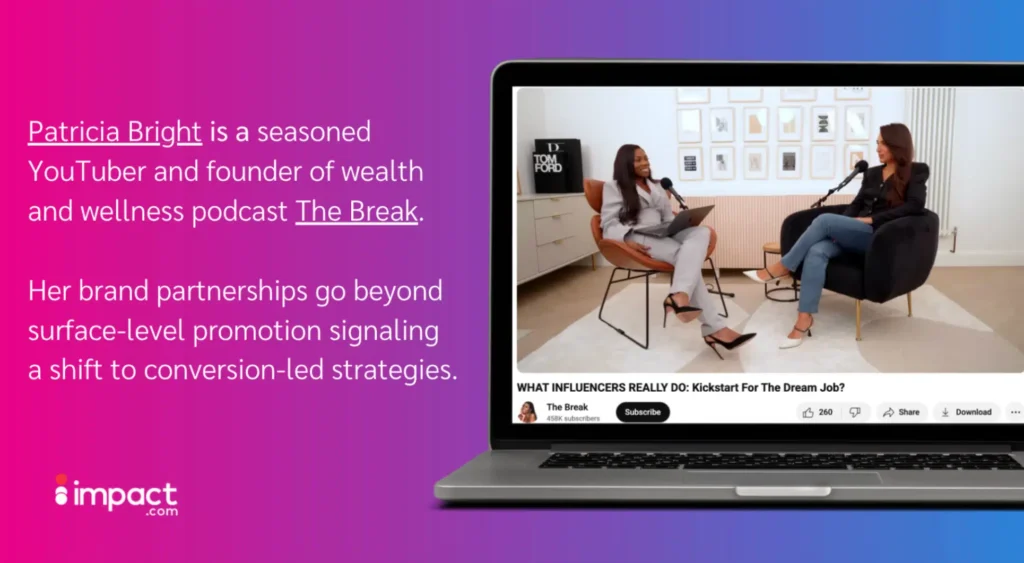
Shifting from awareness to conversion-led creator campaigns
Brands are moving away from one-off influencer campaigns and investing in long-term content creator partnerships that drive conversions and lasting value.
Here’s what’s changing:
- Brands want more than reach. They’re looking for trust, consistency, and long-term return on investment (ROI).
- Content creators aren’t just amplifiers. They’re collaborators, building content that aligns with brand goals and audience needs.
- Audiences crave connection, not perfection. Content creators deliver through honest storytelling and community-building.
- Brands are moving away from awareness to conversion-led creator partnerships. Content creators resonate with audiences and turn attention into sales.
Traditional influencer marketing tends to focus on lifestyle and broad appeal. In contrast, the creator economy prioritizes deeper engagement. Creators connect with niche communities, build real relationships, and drive conversions through content that feels genuine and unscripted.
In this blog, we’ll break down:
- The key differences between influencer marketing and the creator economy
- Why audiences trust creator content, and how that trust converts to brand performance
- How brands can drive sustainable growth through authentic creator partnerships
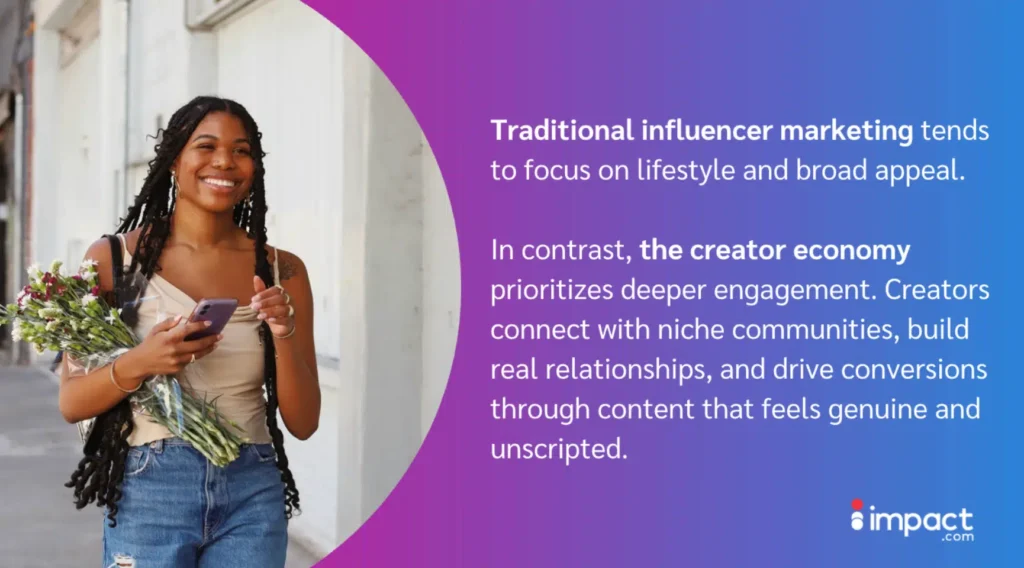
What sets the creator economy apart from influencer marketing
Influencer marketing is rooted in reach. Brands pay individuals with large social followings to promote products. Brands and influencers may collaborate on one-off campaigns or longer-term engagements.
The creator economy is built on value. With U.S. marketers projected to spend $10 billion on social media-sponsored content in 2025—surpassing previous forecasts—it’s clear that the demand for impactful creator-driven content is only growing.
Creators monetize their skills, content, and communities across multiple channels:
- Subscriptions
- Digital products
- Affiliate links
These savvy partners do more than promote products. They build entire ecosystems around their content. Instead of chasing quick wins or short-term virality, creators focus on long-term engagement and trust with their audience.
Influencers broadcast while creators connect
Traditional influencers tend to cultivate aspirational, celebrity-like personas. Their content often leans into trends, lifestyle imagery, and mass appeal. While their content can generate visibility, it doesn’t always translate into conversions.
Content creators focus on building community through relatable, value-driven content. Whether it’s tech tutorials, parenting advice, or sustainable fashion hauls, their audiences show up not just for entertainment, but for guidance and real recommendations.
And that trust makes a difference. While 37 percent of followers say they turn to influencers for inspiration, 60 percent of consumers say they trust creators who are relatable.
That relatability turns views into conversations now and conversions later.
Brand tip: Prioritize creators who value authentic storytelling. This ensures partnership strategies align with audience interests and bolsters credibility.
Content creator Tina Angelina adds that storytelling and relatability are key priorities, with brands requesting creators to share personal stories in favor of straightforward product demos. Why? It builds emotional connections.
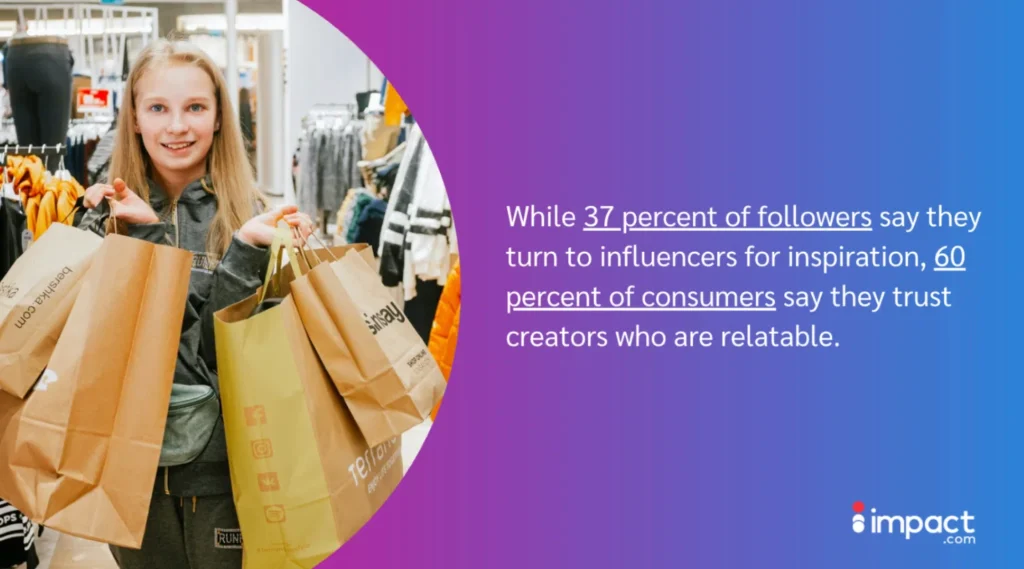
Why brands are betting big on content creator partnerships
In 2025, more brands will move budget away from splashy influencer campaigns toward conversion-focused creator partnerships.
Creator economy expert Lindsey Gamble echoes this sentiment, adding brands want to better understand their creator partnerships’ lower-funnel impact. And they’re ensuring ways to measure this impact.
Lindsey explains that the current landscape is ideal, with brands seeking more performance-based campaigns, technology simplifying their execution, and creators embracing affiliate marketing as a sustainable income source.
The reason behind this change is that creators consistently deliver:
Higher conversion rates
Creator audiences are more likely to take action because the content feels genuine, not forced. 64 percent of consumers repeatedly purchase based on a creator’s recommendation or review.
Longer content lifespans
Evergreen YouTube videos or blog posts drive traffic for months, sometimes years, vs the 24-hour shelf life of a trending Reel.
Deeper audience trust
Creators build loyalty through consistent value. It’s the difference between a billboard you pass on the highway and a friend who texts you a product they actually love.
89 percent of consumers trust personal recommendations over any other channel.
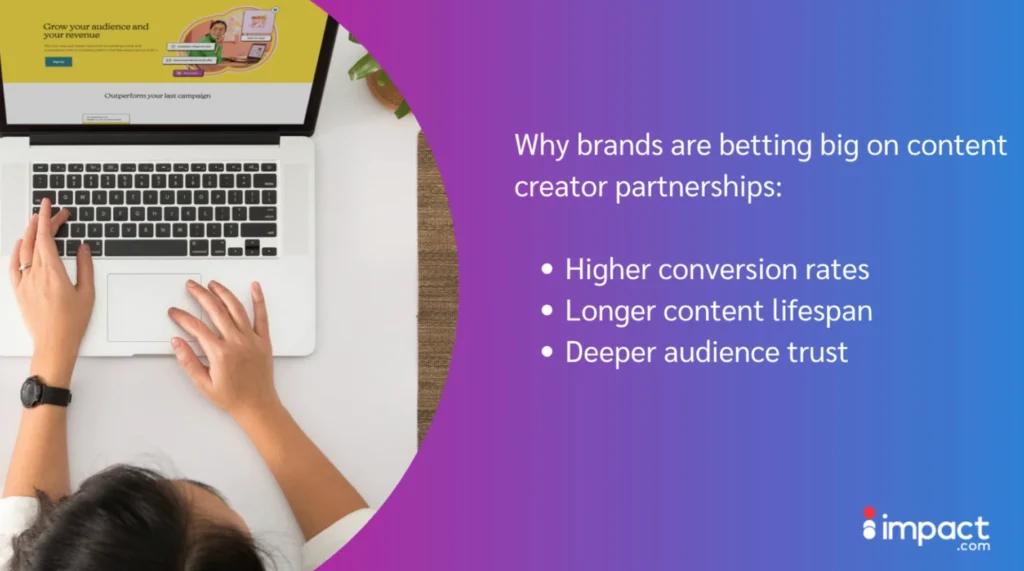
Influencers vs content creators: Key strategic differences
Partnerships have shifted from being purely transactional, focused on deliverables and rates, to something more strategic. Brands now have access to more data and insights, which play a key role in shaping collaborations and projects.
Let’s break down how influencers and creators approach content and why it matters for your brand.
| Aspect | Influencers | Content creators |
| Primary goal | Maximize reach and visibility | Deliver long-term value and build trust |
| Platform strategy | Focus on 1–2 platforms (e.g., TikTok, Instagram) | Diversify across YouTube, newsletters, blogs, podcasts, and more |
| Content style | Trend-driven, aspirational, lifestyle-focused | Educational, relatable, and value-driven |
| Longevity of content | Short shelf life (e.g., Reels peak in ~19 hours) | Evergreen content performs for months or years (e.g., YouTube: 8.8 days) |
| Audience engagement | Broad, less targeted, visibility often doesn’t equal conversions | Niche communities with higher trust and engagement |
| Revenue model | Sponsored posts, brand deals | Multi-channel: Affiliate links, subscriptions, digital products, etc. |
| Brand value | Quick bursts of visibility | Compounding ROI and sustained conversions |
According to Johanna Voss, CEO and Founder of the Johanna B. Voss Agency, partnerships have shifted from being transactional and focused on deliverables and rates. Now, they are influenced by the wealth of information available to brands.
Platform focus: One platform vs many touchpoints
Let’s look at the different approaches to social media influencers vs content creators use:
Influencers: Hyperfocus on a platform for short-term gains
Influencers typically focus on one or two platforms where they’ve built the biggest following. For example, on Instagram, an influencer may share carefully curated photo grids and high-profile collaborations.
On TikTok, it’s all about hopping on trends and delivering entertaining content that grabs attention fast.
Adopting this strategy can work well for reach, but it’s often short-lived. Influencers tend to rely heavily on sponsored posts, one-off brand deals, and a steady flow of content to stay relevant.
Mega-influencer Addison Rae, rose to fame through viral TikTok dances and quickly attracted major brand deals with companies like American Eagle and Sephora. Her strategy relies on visibility and trend alignment, with most content concentrated on TikTok and Instagram.
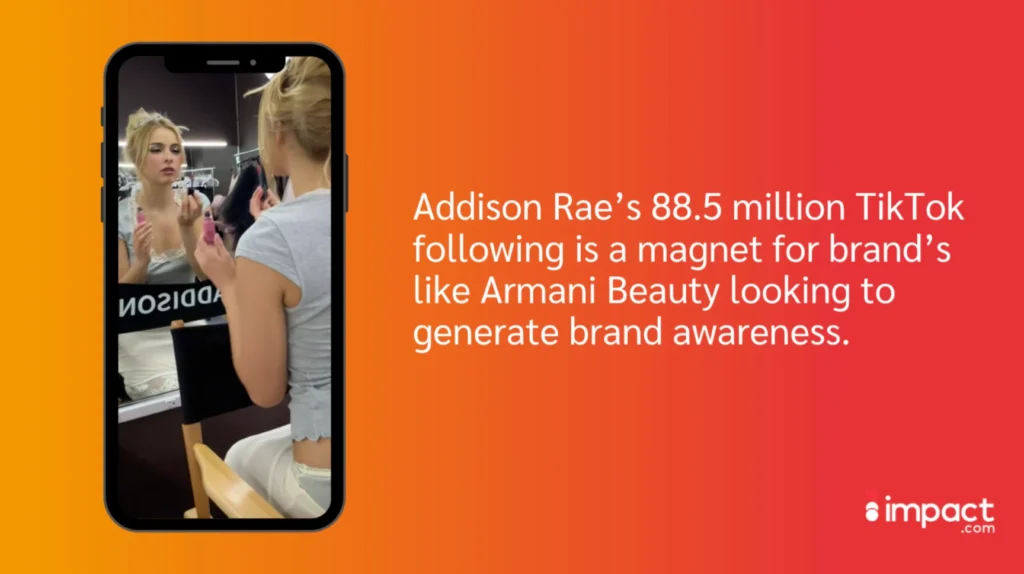
Content creators: Building ecosystems across channels for deeper connections
Content creators take a different approach. They build ecosystems that span multiple platforms. Depending on the creator, the platforms they use to connect with their audience may include:
- A YouTube channel with in-depth tutorials
- A Substack newsletter with exclusive reviews
- A podcast where they dive deep into niche topics
- An Instagram feed that engages with their community
- An affiliate storefront where they recommend tools and products they genuinely use
A multi-platform strategy gives creators more monetization paths and more ways to meet their audience at different stages of the customer journey. From ad revenue to affiliate earnings to paid subscriptions, their income and influence are diversified.
Content creator Ali Abdaal monetizes a deeply engaged productivity-focused audience through YouTube ad revenue, online courses, affiliate links, newsletters, and brand sponsorships—all while growing across platforms.
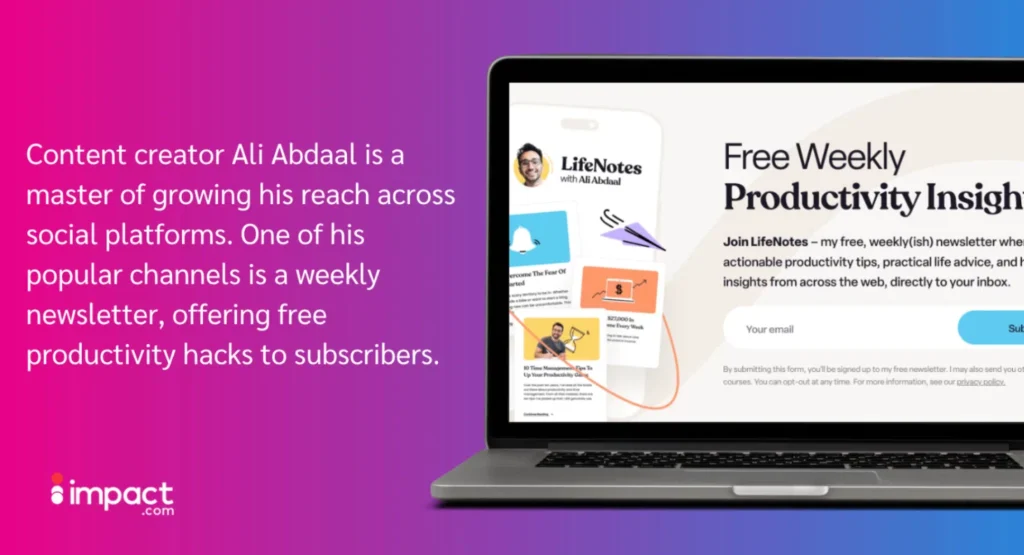
Content longevity: Evergreen vs ephemeral
Influencers often have a viral mindset. Their content is tailored for immediate attention, whether it’s a trending dance, challenge, or perfectly filtered story. It works for visibility, but it fades fast.
Creators, on the other hand, prioritize evergreen content that continues delivering value (and results) long after it’s published. Educational videos, tutorials, product breakdowns are all types of content that drive engagement and conversions for months or even years.
Camila Coelho is a fashion and beauty influencer known for her curated Instagram aesthetic and brand collaborations. Her posts often align with seasonal trends and product launches, driving high visibility in a short time frame.
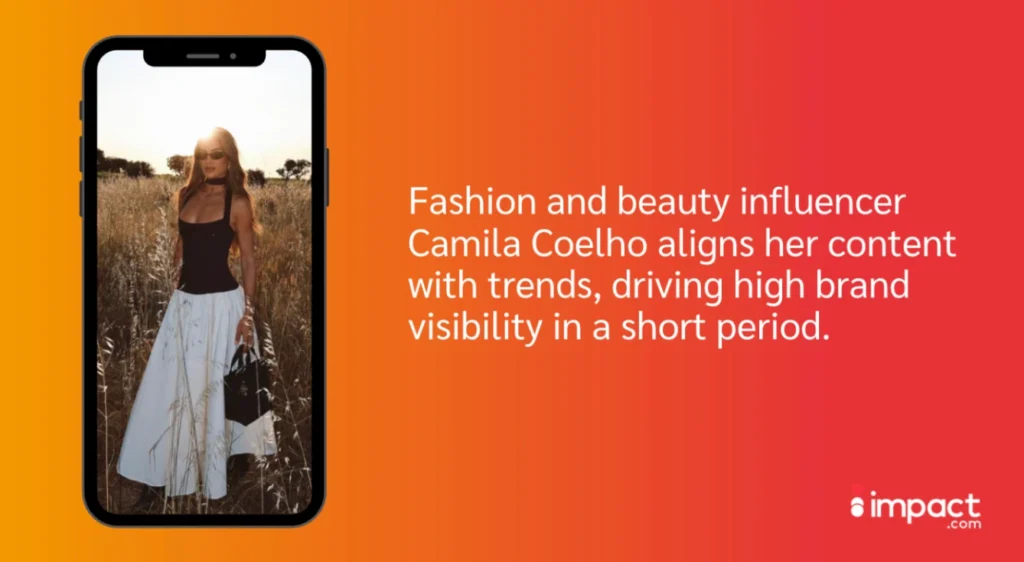
But that impact is fleeting. Instagram posts typically reach half their total engagement within just 1,185 minutes (~19 hours), making every campaign a race against the clock.
Compare that to Austin Evans, a tech and gaming creator known for in-depth YouTube reviews and product comparisons. With more than 5 million subscribers, his videos on gaming and productivity tools remain relevant for months, sometimes years, after publishing.
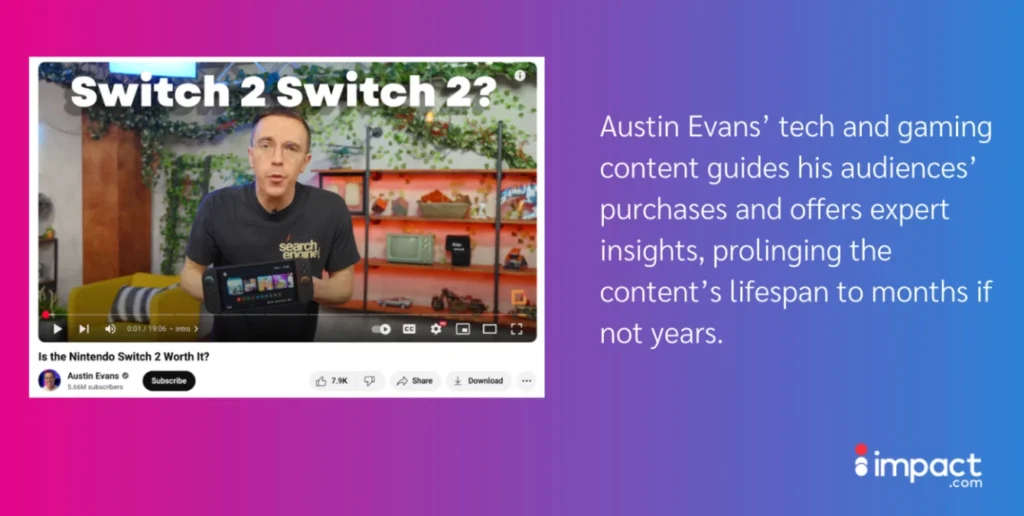
YouTube content holds half its engagement for over 12,700 minutes (~8.8 days), making it a smarter bet for brands focused on long-term performance and affiliate revenue.
A tech review or tutorial by a creator like Austin Evans continues to drive traffic and conversions long after it goes live. For brands, that means consistent clicks, stronger ROI, and content that works long after the campaign ends.
Why brands prefer creators for long-term ROI
When it comes to long-term results, creators offer brands a clear advantage. Their content is:
- Built to last: A single YouTube video or blog post can keep driving affiliate sales long after it’s published.
- Versatile: It’s easy to repurpose across social channels, email campaigns, and even landing pages.
- Trust-driven: Audiences see creators as relatable guides, not polished spokespeople.
It’s this mix of trust, staying power, and adaptability that makes creators such a strong investment, especially for affiliate and performance-based programs. While influencers may deliver a quick spike, creators offer steady, sustainable growth.
Budget shifts, trends, and beyond: Strategic benefits of partnering with content creators
In 2025, brands are actively shifting budgets from traditional influencer campaigns to creator partnerships. It’s no surprise why.
According to Influencer Marketing Hub, only 49.2 percent of brands plan to increase influencer spend this year, down from 59.4 percent in 2024
At the same time, more marketers are embracing creator commerce and social commerce models. They’re prioritizing niche audiences, authenticity, and measurable performance instead of vanity metrics like reach and clicks.
Why is authentic creator marketing winning brand budgets?
As audiences grow more selective about the content they trust, creators who offer authenticity, expertise, and community are becoming the go-to partners for brands focused on performance and long-term growth.
This signals a shift from awareness to conversion-focused partnerships. Here brands can target the 56 percent of consumers who purchase directly via a social platform’s shopping feature.
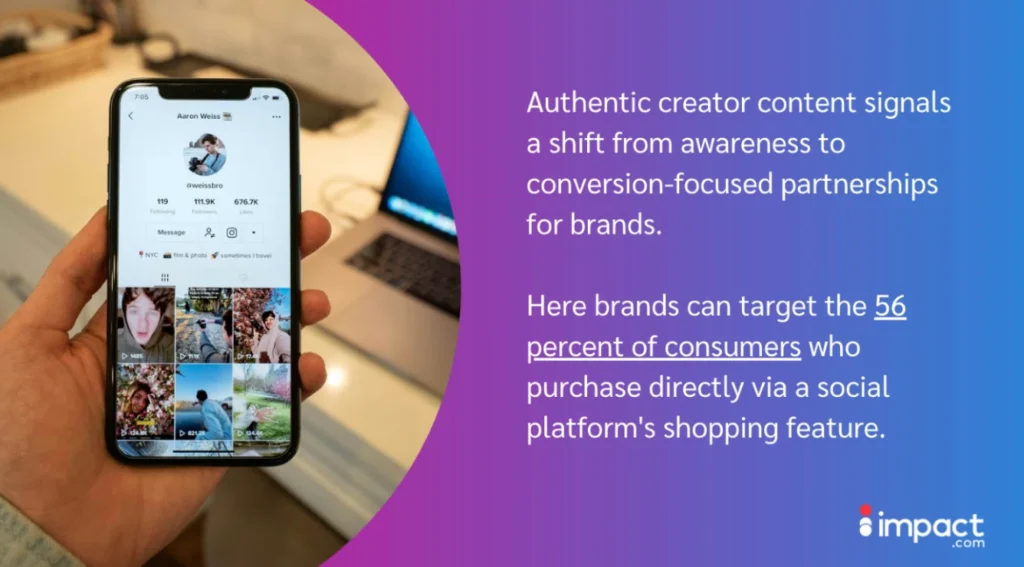
Here’s why content creator partnerships capture more of the budget and foster higher conversion rates.
Build trust through authentic voices
Brands embrace creator-led affiliate programs because audiences see creators as peers instead of polished spokespeople.
Social-commerce platforms now make direct purchasing easier during creator content. TikTok Shop unboxings or shoppable Instagram posts all help passive followers turn into active shoppers.
Reach niche engaged audiences
A staggering 88 percent of Americans participate in niche online communities. Brands are partnering with micro-creators like product reviewers or subject-matter experts to connect with highly targeted segments.
These creators may have smaller audiences, but their relevance and trustworthiness often deliver better results than broader campaigns.
Drive sales through genuine recommendations
Creator recommendations are rooted in real experience, leading to higher conversion. Affiliate links embedded in evergreen content (tutorials, reviews) continue driving traffic and purchases well beyond the initial post.
Save costs with performance-based models
With affiliate-based partnerships, brands only pay creators when sales occur, reducing campaign risk and maximizing ROI.
Caroline Hindman, Senior Manager of Creator Services at impact.com, cites performance marketing as the biggest influencer marketing trend of 2025. She adds that by blending affiliate and creators models, brands can build communities and thereby boost conversion rates.
Caroline highlights the value of collaborating with smaller creators who engage audiences effectively while offering a more cost-efficient approach.
She explains that by focusing on performance-driven programs with nano and micro-creators, brands can optimize their strategies and reduce costs. Running upper-funnel and conversion campaigns simultaneously also helps drive measurable results.
Expand visibility through diverse creators
A network of creators across platforms such as YouTube, newsletters, TikTok gives brands multiple touchpoints and wider exposure.
Compounding ROI through evergreen content
One of the biggest advantages of working with creators is their ability to produce evergreen content. Tutorials, reviews, and how-to videos stay relevant long after they’re published.
This is a major difference from influencer trends, which often peak quickly and fade just as fast. A TikTok or Instagram Reel might get a burst of views in the first 24 hours, but the impact usually ends there.
Evergreen content, on the other hand, keeps working. It drives search traffic, earns shares, and continues generating affiliate clicks and brand visibility over time.
For example, creator Jenn Im regularly shares life lessons, book recommendations, and travel vlogs on YouTube, which continue to gain views and conversions months after going live. Her content doesn’t rely on viral trends. Instead she delivers value that encourages her audience to return.
In her Adulting Habits That Improved My Life video, Jenn shares a discount code for bed linen brand Brooklinen.
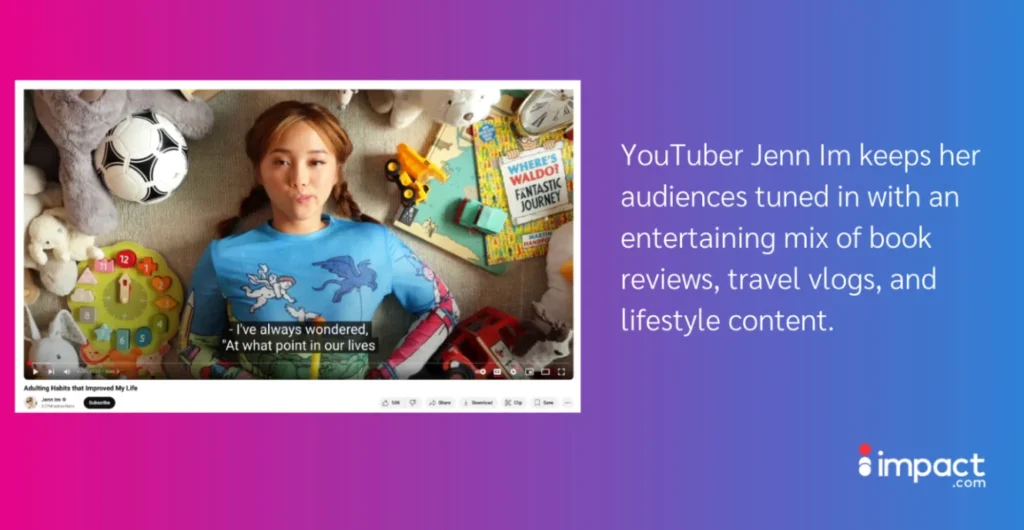
That kind of staying power is what makes creator commerce such a smart long-term investment. One well-made video or blog post can deliver results for months or even years.
Predictions for the creator economy in 2025 and beyond
The creator economy isn’t slowing down, it’s evolving fast. From smarter tools to new monetization features, the market is becoming more sophisticated and rewarding for content creators and brands.
Here’s what to expect in the months ahead:
AI-powered content scale
Advancements in AI will help content creators maximize output. AI tools can currently help with everything from auto-generated captions and smarter video edits to thumbnails and post scheduling.
Creators can now spend less time on manual tasks and more time crafting standout content. Expect a surge in polished, high-quality content produced at speed and scale.
Expanded platform monetization
Social platforms are doubling down on creator monetization. Features like in-app shops, tipping, subscriptions, and native affiliate tools are becoming standard.
This gives creators more ways to earn and gives brands more opportunities to collaborate in meaningful, measurable ways.
Rise of niche “micro‑creator” commerce
Brands are shifting focus from broad influencer reach to hyper-targeted micro-creator partnerships. These creators speak directly to niche communities, and drive serious results.
Their accessibility and relatability make them the most popular influencer tier, resonating with 46 percent of audiences.
Small and mid-sized brands see strong results from this group, with micro-creator posts generating 2.4 to 6.7 times more engagement than the brand’s own content. Larger brands often collaborate with multiple micro-creators simultaneously to expand reach, while keeping content personal and targeted.
The fusion of social and creator commerce
The line between content and commerce is blurring fast. In the U.S. alone, social commerce sales are projected to surpass $100 billion in 2026. As platforms roll out more shoppable features, creator-led storytelling will become a cornerstone of the path to purchase.
Strategic key takeaways for brands
- Consider reallocating budgets from short-term influencer investments into creator-led affiliate partnerships.
- Diversify across creator tiers––niche micro-creators offer better engagement than macro influencers.
- Adopt evergreen content models to benefit from long-term ROI.
- Integrate social commerce tactics with shoppable videos and livestream drops with creator content.
When brands lean into creator commerce, they gain deeper trust, higher conversions, tighter cost control, and stronger performance across the funnel.
Taking this approach aligns perfectly with impact.com’s affiliate-powered platform, which connects creators and brands in a measurable, scalable way.
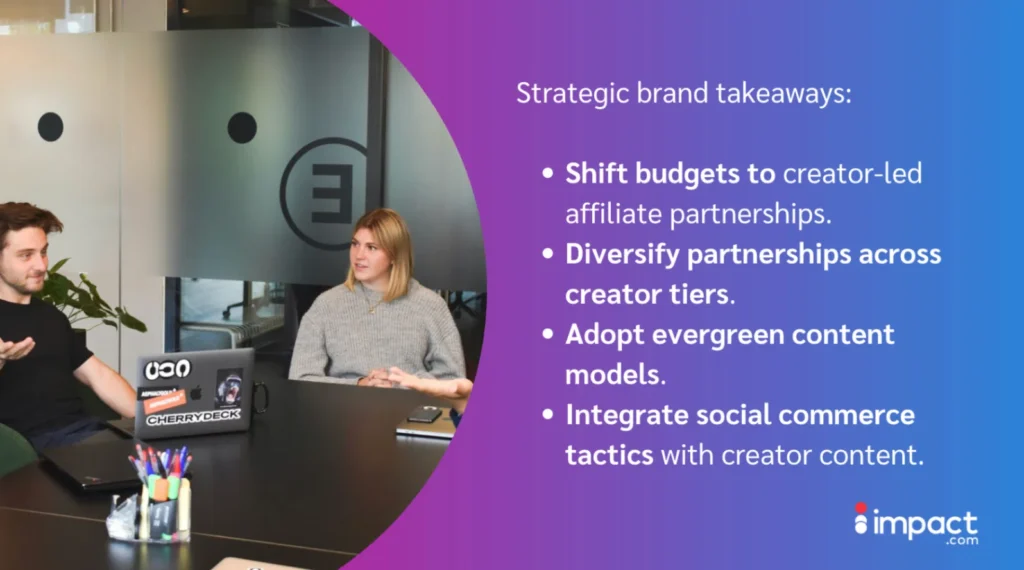
The final puzzle piece: How technology helps brands thrive in the creator economy
To succeed in the creator economy, brands need more than good instincts and trending content.
They need technology built for modern partnerships.
The roadblock: Tools that don’t talk to each other
Most influencer tools stop at discovery. They help brands find talent, but don’t manage the full life cycle of a creator campaign.
Traditional affiliate networks aren’t much better, they’re often built with publishers in mind, not creators. And while social platforms are great for reach, they lack the backend infrastructure to support partnership operations at scale.
Brands are often left to juggle spreadsheets, DMs, contract PDFs, and siloed analytics.
The solution: A platform built for partnerships
That’s where impact.com comes in. Our partnerships platform is designed to help brands scale authentic creator relationships and drive measurable results without the chaos.
With impact.com, you can:
- Run creator-led affiliate programs and campaigns across social media, blogs, video, and more all from one dashboard.
- Track performance in real-time, across every campaign, platform, and creator. Instantly generate wrap reports to show what’s working (and what’s not).
- Customize creator compensation with flexible options combine flat fees, commissions, gifts, or performance bonuses to match your strategy and budget.
- Bridge the gap between creators and brands for long-term, meaningful relationships: Collaborate easily with creators by sending messages, assigning tasks, and managing all communications directly within the platform.
- Speed up onboarding with automated contracts and agreement templates. No more back-and-forth emails or unclear expectations.
- Set clear goals from the start with the Brand Defines features. Assign specific tasks, then invite creators to propose additional deliverables that align with their strengths.
- Support multi-platform content by creating unique tracking links and monitoring performance across TikTok, Instagram, YouTube, blogs, and more.
The creator economy is built on relationships, but relationships don’t scale without the right infrastructure. With impact.com, brands can move beyond one-off collaborations and build a repeatable, measurable creator strategy that drives long-term ROI.

Notta uses impact.com to enter the U.S. market and grow monthly revenue 10x with content creator partnerships
When Notta, a leading AI-powered notetaker, set its sights on expanding into the U.S. market, it turned to the creator economy to make an impact.
Instead of relying on broad influencer campaigns, the brand partnered with niche influencers and content creators who could speak directly to productivity-focused and tech-savvy audiences.
To keep creators motivated and campaigns scalable, Notta offered hybrid compensation models combining flat fees with performance-based commissions for long-term partners.
Using impact.com’s partnership management platform, Notta streamlined everything from creator discovery and onboarding to performance tracking and payout management, all from one dashboard.
Notta increased its monthly revenue by 10x, proving the power of strategic creator partnerships backed by the right tech.
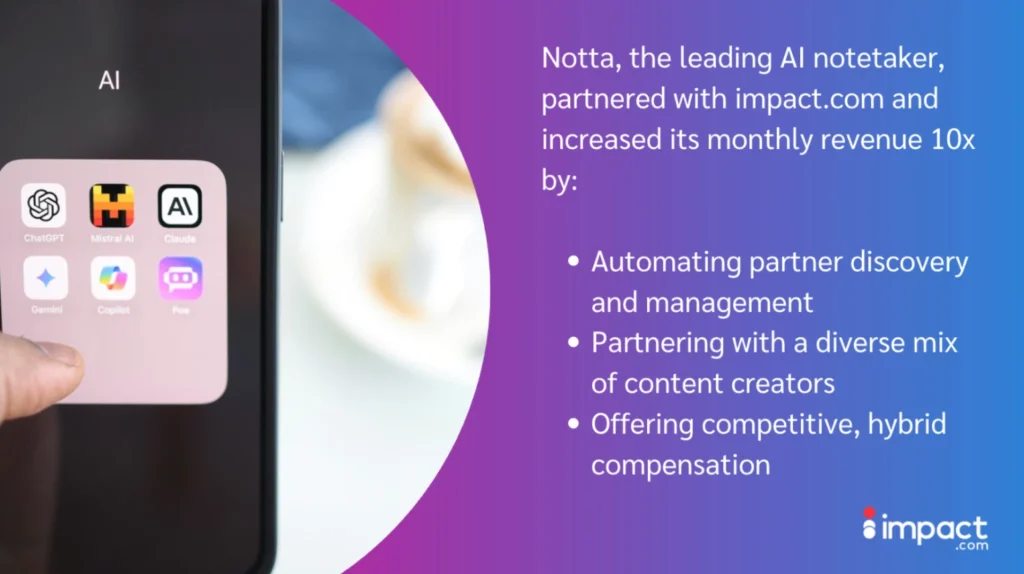
FAQs
The creator economy is a broad ecosystem of individuals who build and monetize their own content across various platforms. These can include YouTube videos, TikToks, Substack newsletters, or Patreon memberships.
These creators often earn income through multiple channels, like subscriptions, affiliate links, ad revenue, or digital products.
Influencer marketing is a more specific strategy where brands partner with people who have large followings to promote their products. The focus is typically on short-term visibility and reach.
In short, influencer marketing is one piece of the puzzle. The creator economy is the bigger picture since it includes more platforms, more ways to earn, and a stronger focus on community and long-term engagement.
Brands are putting more budget into the creator economy because it gives them direct access to authentic, highly engaged communities. Creators build trust with their audiences by sharing content that speaks to specific interests—and that trust carries over to the brands they work with.
Unlike traditional ads, creator content feels personal and relatable. It also opens the door for co-creation, storytelling, and long-term partnerships, helping brands boost visibility, reach new markets, and build lasting customer loyalty.
The creator economy helps brands connect with the right people in a more authentic, impactful way. By partnering with creators, brands can tap into highly targeted audiences and produce relatable, high-quality content that feels more like a trusted recommendation than an ad.
These partnerships also help brands stay current with trends, build stronger community ties, and create content that actually drives engagement and sales. Broad reach alone isn’t enough. What drives long-term growth is building meaningful connections with the right audiences.
To build a successful affiliate program with creators, brands must align their campaigns with creators’ audiences and niche. Start by choosing creators whose content and values resonate with your brand. Offer competitive commission rates and provide easy-to-use tracking tools to monitor performance. Additionally, supply creators with high-quality promotional assets to simplify their content creation process. Clear communication and ongoing support will strengthen these partnerships and boost program results.
Social commerce allows brands to tap into creators’ established audiences, driving higher trust and engagement. By partnering with creators, brands can showcase their products in authentic, relatable ways that resonate with potential buyers. This approach helps increase conversions while building long-term brand loyalty. Additionally, creators can provide real-time feedback on products and campaigns, offering valuable insights. Leveraging popular social commerce tools enables seamless shopping experiences for customers, boosting overall sales.
Turn content creator partnerships into long-term growth
The creator economy has shifted how brands connect with audiences. Unlike traditional influencer marketing, which often focuses on reach, the creator economy prioritizes authenticity, trust, and long-term impact.
Content creators bring engaged communities, lasting content, and measurable ROI. Their ability to build genuine relationships with followers makes them powerful partners for brands that want to grow sustainably.
To succeed in this fast-evolving market, brands need the right tools to support creator partnerships from start to scale. That’s where impact.com comes in.
Book a demo with impact.com today to unlock the full potential of authentic creator marketing, and stay ahead in the creator economy.
Stay up to date with our latest resources here:
- The ultimate guide to influencer marketing in 2025
- 8 influencer marketing trends for 2025: 11 experts reveal how to increase ROI with performance-driven creator partnerships
- Building a profitable creator community: How OLIPOP’s hybrid commission approach drives 12% of sales
- How to pay content creators in 2025: 7 proven payment methods that drive results
- Content creator affiliate strategy: How Charlie Chang hit 80% affiliate income with searchable video content








